Cebu Taoist Temple: An Ornament of China in the Philippines
The history of the Chinese presence in the Philippines dates back to pre-Hispanic period. Chinese merchants sailed to the Philippines and established a trading relationship with the native Filipinos. The trade marked the beginning of a major influence and significant contributions to the country’s history and culture.

For centuries, the Chinese community has been instrumental in the country’s cultural growth and change. Regarded as economic elites with their business acumen, hard work, and vast business networks, these Chinese play a leading role in the Philippines' business sector and dominate the Philippine economy today.

Despite an ongoing territorial dispute between the Philippines and China, it cannot be overlooked that through their constant trade relations as far back as the 10th century, a partnership has subsequently blossomed which brought about close ties and interracial marriage. The blending of two nations gave way to a vibrant Filipino-Chinese culture in the Philippines. This is evident in a number of Filipino-Chinese markers, Chinatowns, and Chinese temples scattered all over the country, to commemorate the bond of friendship and long association between the Filipinos and Chinese.
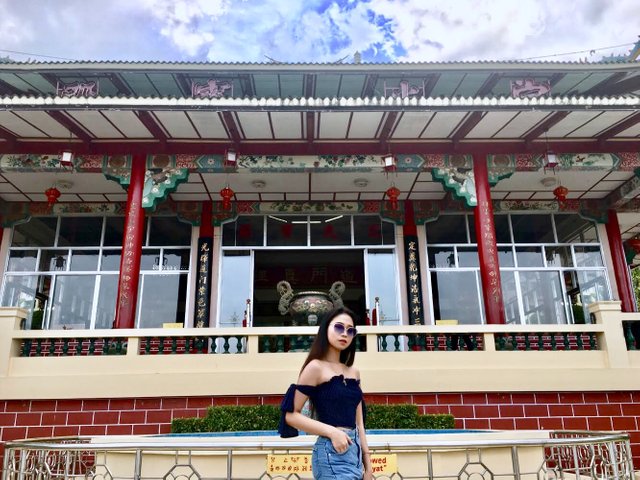
As a result of the influx of Chinese into the country, Chinese immigrants brought with them many of their religious beliefs and practices, as well as their traditional architecture. In fact, some of the Filipino-Chinese today still practice traditional Chinese religions solely and temples can be found where the Chinese live. For a taste of history, architecture, culture and spirituality, get your cameras ready and check out this awe-inspiring destination that is definitely worth a cultural pilgrimage!
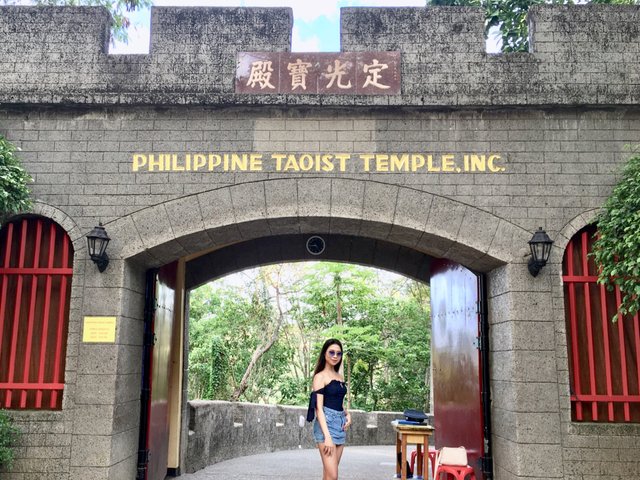
Perched high on a northern hill overlooking the city, Cebu Taoist Temple is a Taoist temple located in Beverly Hills Subdivision of Lahug, Cebu City, Philippines. The temple is the center of worship for Taoism — a Chinese philosophy and religious belief based on the teachings of the ancient Chinese philosopher, Laozi. Cebu Taoist Temple is an integral part of Cebu’s tourism. Built by Cebu's substantial Chinese community in 1972, the temple has now become a tourist attraction in the city as it is open to worshipers and non-worshipers alike. There are no specific days set aside for sightseers to visit the temple. Taoism states that anybody, irrespective of nationality and religion, is welcome to pray, meditate and offer at the temple. Step off the temple through a grand castle-like entrance, and leave behind the bustling cacophony of the city to enter a different world that evokes a bygone era.

The ethereal beauty of Cebu Taoist Temple has long attracted the gaze of tourists from all over the world. With an elevation of 300 metres (980 ft) above sea level, the temple is a towering, multi-tiered, multi-hued attraction accessible by three separate winding routes. One of which is the main entrance passing the pathway of a replica of the Great Wall of China. There are millions of people dreaming about one day standing atop the Great Wall of China, considering that is one of the most appealing attractions all over the world owing to its architectural grandeur and historical significance. To personally step foot on the famous wall is a huge achievement, however, it is a privilege not everyone can afford. So, if you’re in the Philippines and you don’t have enough resources for a trip to China, instantly head over to Cebu Taoist Temple for a visual feast! A sensational place awaits you that will surely captivate your heart and soul.
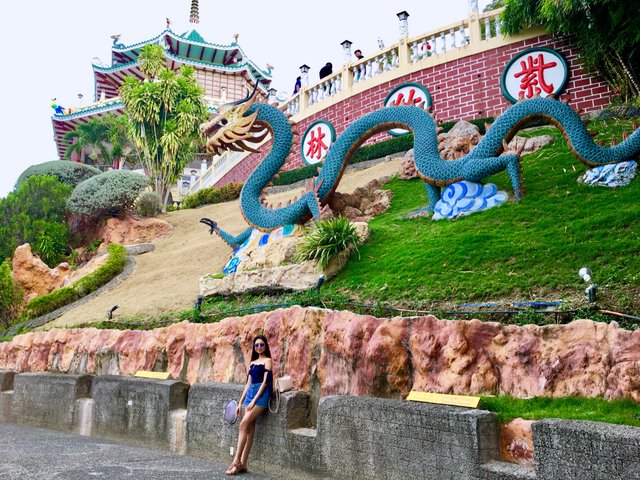
As you wend your way to the temple, you'll stumble across a striking statue of a Chinese dragon, immortalized in cement and paint. It is said that the dragon is a totem of the Chinese nation, a symbol of China and of Chinese culture. According to Chinese mythology, the Chinese dragon is a benevolent creature with divine origin, despite its menacing appearance. The Chinese depicted the dragon as a mythical beast with reptilian traits throughout history. It traditionally symbolizes potent and auspicious power, particularly control over water phenomenon. It is also believed to be the harbinger of good luck, success, and affluence. Furthermore, it represents an intangible wire uniting Chinese people, keeping their unrelenting and pioneering spirit to get with the times.
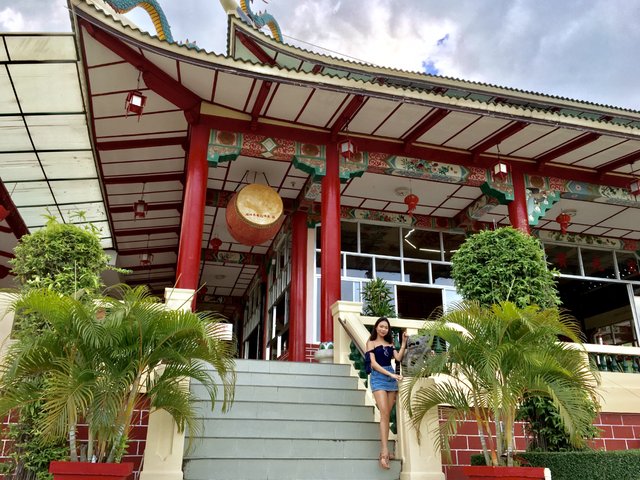
Taoism pursues a prolonged and fruitful life. Thus, the theme is greatly reflected in the decorations used in temple construction. The facade of the main hall — where Taoists perform their religious ceremonies, blends taste and ideas with traditional Chinese thoughts and methods of construction. Featuring an architectural symmetry, the main hall is enclosed with glass wall panels. The columns are painted in red and adorned with Chinese calligraphy; the spandrels are intricately designed with red, green, yellow and white images of sun, birds, flowers and vines; and the soffit is shaded in red and white stripes, just the same with the ceiling. A traditional Chinese drum hanging from the soffit serves as an eye-catching display at the porch of the temple. Dangling lamps and lanterns attached on a continuous track add drama to the space, and perhaps to illuminate the crimson colonnade at night.
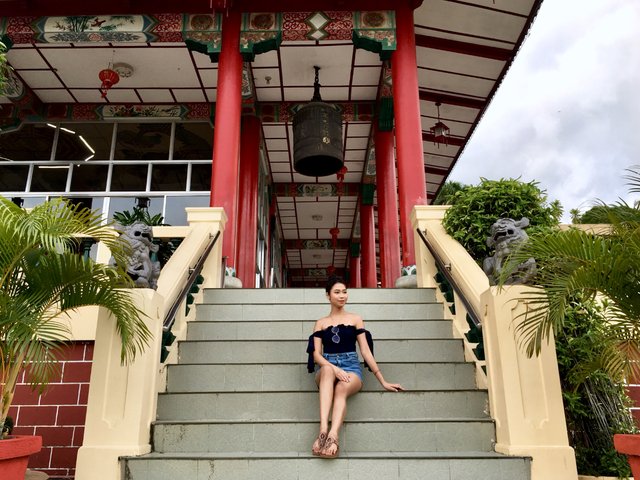
Meant to ward off evil spirits, pairs of Chinese stone guardian lion sculptures are displayed at the entrance stairs of the main worship hall, sitting across from each other. These Chinese guardian lions are sometimes called "Fu Dogs" because of their resemblance to Chow dogs. The name came from the Chinese character Fú which means fortune or good luck. The lions are always depicted in pairs, a manifestation of yin and yang (dark-bright), the female representing yin and the male yang. You can identify the gender by what is placed under its paw. The male holds an embroidered ball under his right paw which represents supremacy over the world, while the female holds a cub under her left paw, signifying strong maternal protective instincts. Symbolically, the female lion protects those dwelling inside, whereas the male guards the structure. These imposing guardian lions were believed to have powerful mythic protective benefits. Moreover, a massive old bell which is made of metal hangs at the right corner of the porch. Inscription of the name of the temple and the year, as well as the symbol of yin and yang can be seen on the bell. When struck, the sound can travel very far. As part of the temple’s rituals, the bell is beaten to draw the devotion of worshippers, and the reverence of ancestral spirits and deities.
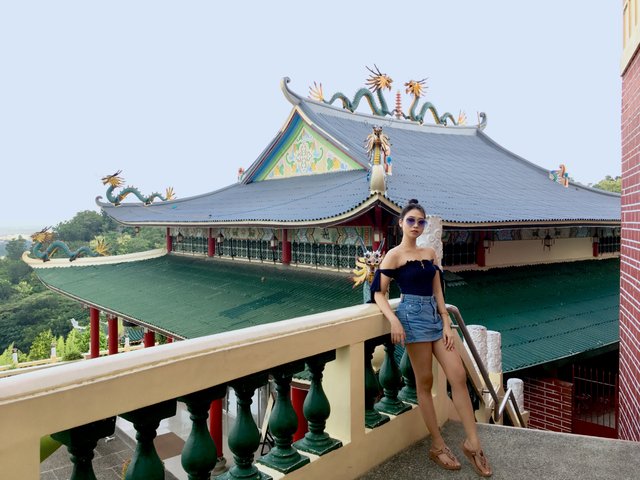
Another unique feature of the temple’s structure is the roof. Effortlessly withstanding the test of time, the main hall has a double-eave hip roof that is made of green glazed roof tiles which matches to other architectural elements of the building. In Chinese culture, the green roof is often associated with prosperity, health, growth and harmony. The upturned eaves, with its ancient principle of staving off harm or evil influences with curves, is dominated by intricately carved stone dragon statues. Dragons looking outward embellish the eight corners of the double roof. The apex of the roof is topped with ridge tiles, and a pair of dragon statues facing each other with a pearl on top of a miniature pagoda between them. The pearl is used as a symbol of wisdom or enlightenment. Since dragons were believed to be supernaturally wise, perhaps it is reasonable that they hold such a treasure. What’s more, dragons being linked with water, safeguards the building from fire.
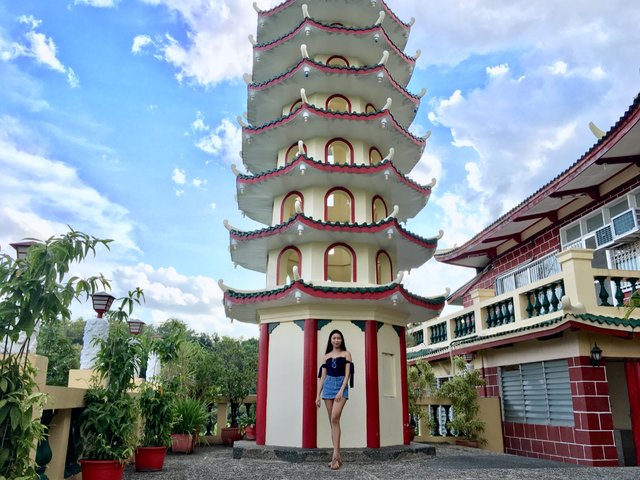
Positioned on the left side in front of the primary hall, a pagoda is standing magnificently. This seven tiered tower with multiple eaves is said to signify blessings from seven northern stars which brings excellent wealth and luck. It is also a temple of knowledge, peace and silence. According to legend, the pagoda has been a tool to tame unruly characters by imprisoning them inside until they were able to attain a state of calm. Additionally, it has commonly been assumed to attract lightning strikes because of its height. This pagoda has a decorated finial at the top of the structure wich functions as a lightning rod that protects the pagoda and its surrounding buildings from lightning damage.
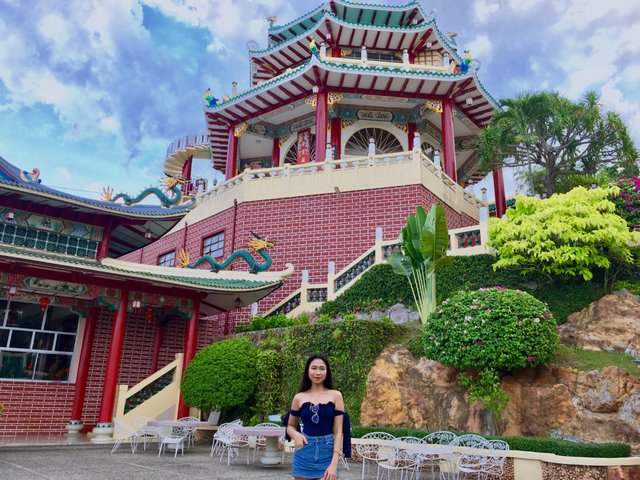
Climbing the stairs at the right side of the main worship hall will lead you to another three-tier pagoda style worship chamber. This multi-roof structure has numerous upturned eaves supported by carved wooden struts and topped with detailed stone sculptures of mythological birds and dragons. Fenghuang, also called Chinese phoenix in Chinese mythology, is the mythical king of all birds. It has a rare appearance, with colorful plumage, which signifies peace, prosperity, grace, and virtue. Its name is a combination of the words feng (male) and huang (female). Following this logic, the fenghuang is often viewed as the sacred union between femininity and masculinity, or a yin and yang harmony. The fenghuang is also regarded as a female entity in relation with the Chinese dragon, which is traditionally deemed as a male. Thus, images of the fenghuang and dragon together represent marital happiness and harmony. Aside from the roof, sun etched glass windows are noticeable, too. Playing an important part in Chinese culture, the sun is an epitome of yang, representing light, heat and vitality. The idea of this Taoist decoration means a glorious sunshine illuminating all things. The power of the sunlight radiates through the darkness, as good will prevail over evil.
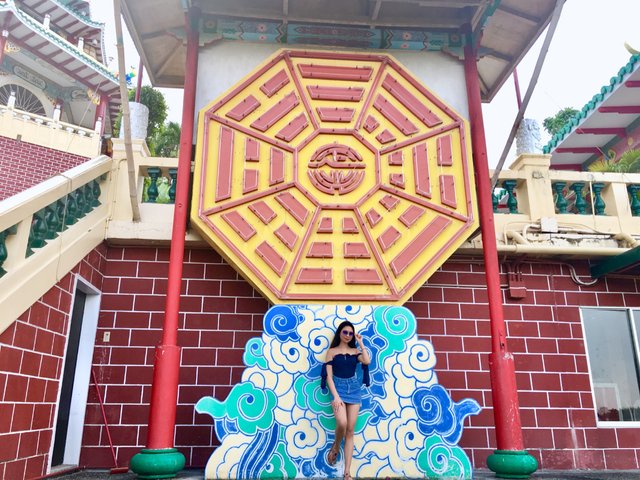
Acclaimed as one of the most important Taoist visual symbols, bagua is an octagon shape with a Chinese religious motif incorporating the eight trigrams of the I Ching (Book of Changes) — an ancient Chinese divination text and the oldest of the Chinese classics. Translates literally as “eight symbols”, the word “bagua” came from Chinese bā (eight) and guà (divinatory symbols). By looking at the bagua, you will see that it is divided into eight trigrams. Each trigram consists of a three-line combination of broken (Yin) lines and solid (Yang) lines, respectively symbolizing Yin and Yang. The associations with each trigram are called: Heaven, Earth, Thunder, Wind, Water, Fire, Mountain and Marsh. The bagua is a tool and a symbol in one. It is a powerful instrument that can fend and reject bad energy. To the contrary, it stands for unity, oneness and harmony. It brings together all the different elements and energies, teaching worshippers how to live a naturally balanced life.
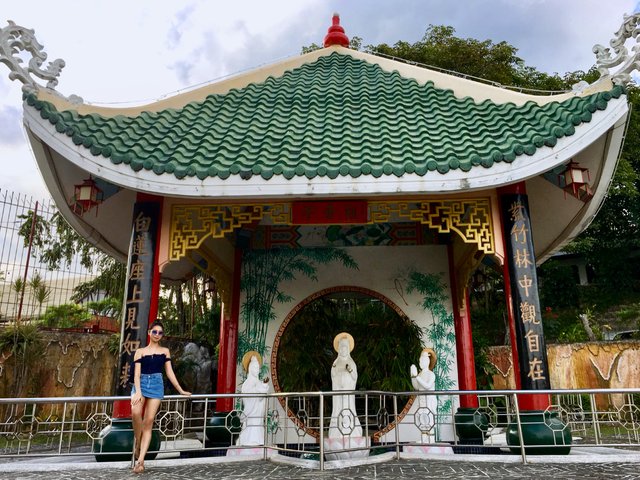
Adjacent to the three-tier pagoda style worship hall is a wishing well shaped like a lotus flower. Stainless steel railing wraps around the well following the form of the well’s surface. The upturned roof is supported by columns painted in red and black with Chinese calligraphic inscriptions. This wishing well wasn't shaped like a lotus for no reason. Lotus, with its unblemished pure beauty, is highly esteemed by Taoists. Due to its quality to bloom in spite of unfavorable conditions, it is considered divine and one of nature's mystical creations that represents beauty, light, purity and life. It is often compared to a person with strong virtues and moral values. This well serves as a reminder that just like the lotus, one should also grow spiritually and do only the right things despite of the bad forces present in the surroundings. Furthermore, three astounding statues, with each standing atop a lotus pedestal highlighted the wishing well. Image of Guanyin, known as the “Goddess of Mercy”, is placed at the center. Revered by Taoists as an immortal, a white flowing robe — white being the symbol of purity, covers her entire form. In her left hand is a sacred jar containing pure water — the dew of compassion; and in her right, a willow branch to sprinkle the divine nectar of life. Guanyin is accompanied by her two acolytes, the girl is called Longnu translated as (Dragon Daughter); and the boy is Shancai (Child Of Wealth).
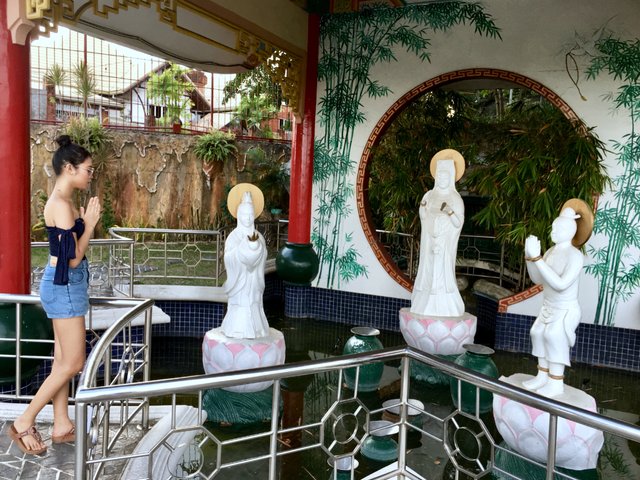
You may also notice an unusual stone wall with a circular opening at the center that serves as a backdrop. Well, the wall is more than just a part of the well’s design. Often called moon gate, this type of architecture was historically used at the gardens of the wealthy Chinese as an entrance to a special place. More than that, this gate has many interpretations. One of which is that the moon gate represents the full moon which is believed to be an auspicious token of abundance, harmony, and good luck. Another explanation claims that it is a barrier opening that leads to a connection between two worlds. The bamboo painting which may seem as the border of the wall, represents the qualities of durability, strength, flexibility and resilience — making it a suitable paragon of virtue for Taoists. The coins found in the wishing well are vestiges of the desires of patrons in hope that their wishes may come true. Some visitors believed that after uttering your wishes, the guardians of the well would grant your desires if you throw coins into the water. However, others said that you have to make sure your coins land inside the vases. In whatever way, the Goddess of Mercy only helps those who lead a life of kindness, honesty, and compassion.
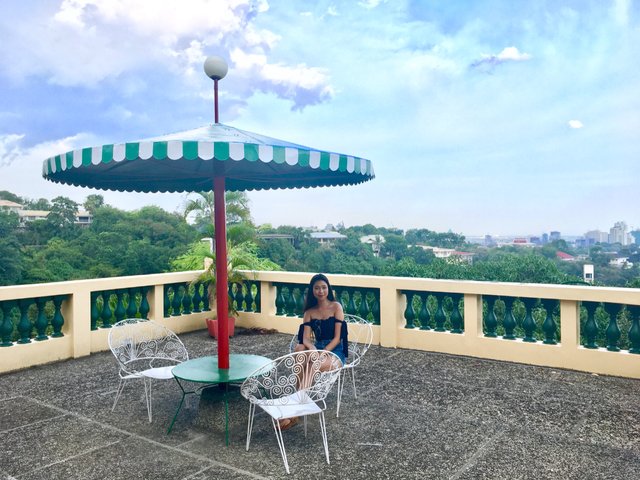
The main purpose of Taoism is to encourage everyone to live harmoniously with nature. As such, Cebu Taoist Temple is built on a mountainside. The grounds of the temple conform to the pre-existing contours of the hill intertwined together by different winding staircases. An observation deck equipped with umbrella tables and chairs awaits visitors at the top. Additionally, it is noteworthy that the viewing platform is enclosed by a balustrade for safety. The deck offers a spectacular panoramic view of the city and its surrounding islands and islets. Sitting cozily in the lap of nature while taking a breath of fresh air provides silence, solitude and stillness for contemplation. You can't go wrong visiting this temple, for this is meant to be a resting place for mind, body and soul.
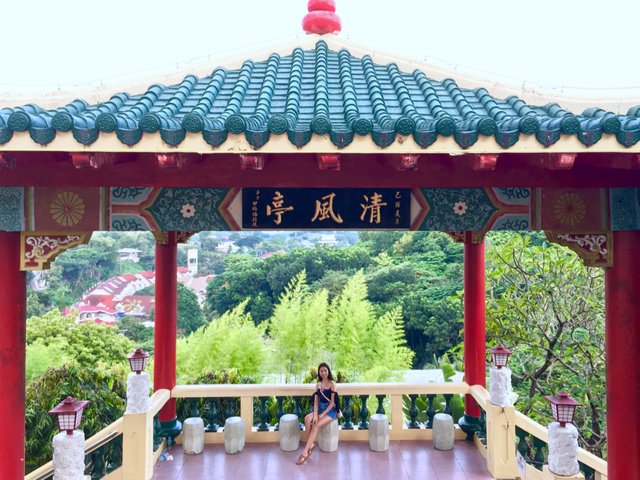
While there is a copious amount of history to see and take pictures at the temple, you are not allowed to capture photos of the prayer rooms’ interior. Also, avoid wearing sleeveless shirts and short pants if you wish to enter the main worship hall. Don’t make the same mistake I did. You may have differences in religious beliefs and practices, but remember that you’re a visitor. Hence, you should pay respect by abiding with the rules and maintaining silence. This temple is sacred to the worshippers; a place for prayer, meditation, and communication with their gods.

Designed to reflect the rapport between humans and nature pursued by Taoists, Cebu Taoist Temple provides visitors an opportunity to experience Taoism, discover and appreciate Chinese culture, as well as to open ourselves up to new experiences. Moreover, the Chinese presence in the Philippines goes to show the undeniable significance of this community in the country’s history and culture.
Congratulations @belvaj! You have completed the following achievement on the Steem blockchain and have been rewarded with new badge(s) :
Click on the badge to view your Board of Honor.
If you no longer want to receive notifications, reply to this comment with the word
STOPYour legs are so long!
You think so? Hehe
Congratulations @belvaj! You have completed the following achievement on the Steem blockchain and have been rewarded with new badge(s) :
Click on the badge to view your Board of Honor.
If you no longer want to receive notifications, reply to this comment with the word
STOP